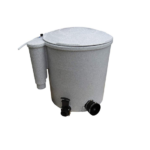CEFAS have detected the virus which causes SVC during the routine screening of imported ornamental fish. The sample, which was taken in the middle of February was confirmed positive earlier this week.
Mainland UK is classified as an eradication zone for SVC whilst in Ireland and the off shore islands of Guernsey, Jersey and the Isle of Man, these areas are classified as disease free zones. The fish originated from a source in Hong Kong and the Chinese authorities have a control plan for their fish farms. There may be some import restrictions as a result of this that DEFRA may wish to implement.
Although it is most unlikely that anybody reading this notice will ever come across this disease, we must all be aware and vigilant in our fight to protect our freshwater fish stocks from SVC.
What is Spring Viraemia of Carp?
Spring Viraemia of Carp or SVC is a contagious viral disease of carp and other fish of the cyprinid family (goldfish, roach, rudd, tench) pike and Wels catfish. The disease generally develops as water temperatures rise above 7°C – hence the name spring viraemia. There is no cure for the disease. Fish of all ages are susceptible if they have not previously been exposed to the virus. The UK is normally free of SVC so our fish are very vulnerable to it.
Does SVC affect carp only?
SVC affects common carp (including all variants, such as mirror, leather and koi carp), grass carp, bighead carp, silver carp, crucian carp, goldfish, orfe, pike, roach, rudd, tench and Wels catfish. Fish of all ages are susceptible if previously unexposed to the virus. The disease is transmitted from fish to fish by contact. Carrier fish spread the virus through their faeces, urine, reproductive fluids or external mucus secretions.
When does it occur?
SVC outbreaks generally develop as water temperatures rise above 7°C, i.e. in spring. Most deaths occur between 10°C and 15°C. Above 17°C, deaths reduce significantly. Above 23°C, death is rare but the virus can remain viable within the fish.
How do I recognise the disease?
 Signs of the disease vary but can include darkening of the skin, swollen eyes, abdominal swelling (dropsy), pale gills, trailing faeces casts and protrusion of the anus. Infected fish may be lethargic and show signs of bleeding from the gills and skin. They tend to gather in the margins and around inlets and feeder streams. Of course, not all suspicious deaths are caused by SVC. Virus isolation in the laboratory is needed to confirm the disease.
Signs of the disease vary but can include darkening of the skin, swollen eyes, abdominal swelling (dropsy), pale gills, trailing faeces casts and protrusion of the anus. Infected fish may be lethargic and show signs of bleeding from the gills and skin. They tend to gather in the margins and around inlets and feeder streams. Of course, not all suspicious deaths are caused by SVC. Virus isolation in the laboratory is needed to confirm the disease.
What’s the cure?
There isn’t one! The only protection from SVC is prevention. There is no treatment or licensed vaccine available in the UK.
What must I do if I suspect my fishery is infected with SVC?
If you suspect the presence of SVC, or any other notifiable disease, then you must inform the Fish Health Inspectorate who can be contacted at:
England and Wales
Fish Health Inspectorate
Centre for Environment, Fisheries and Aquaculture
Science (CEFAS), Weymouth Laboratory
Barrack Road, The Nothe
Weymouth
Dorset DT4 8UB
Tel: 01305 206673
Website: www.efishbusiness com
Scotland
Fisheries Research Services
Marine Laboratory
PO Box 101, Victoria Road
Aberdeen AB11 9DB
Tel: 01224 876544
Website: www.frs-scotland.gov.uk
If you are at all worried about your Koi, their behaviour or any other matter relating to your pond, do not hesitate to call (01243 572762) Rod, Gerry or David. Help is always on hand.
 The additive contains a highly concentrated pure bacterial culture, designed to provide instant nitrification. This is ideal for adding to new filter systems, when adding new fish and for the quarantine system.
The additive contains a highly concentrated pure bacterial culture, designed to provide instant nitrification. This is ideal for adding to new filter systems, when adding new fish and for the quarantine system.

 Signs of the disease vary but can include darkening of the skin, swollen eyes, abdominal swelling (dropsy), pale gills, trailing faeces casts and protrusion of the anus. Infected fish may be lethargic and show signs of bleeding from the gills and skin. They tend to gather in the margins and around inlets and feeder streams. Of course, not all suspicious deaths are caused by SVC. Virus isolation in the laboratory is needed to confirm the disease.
Signs of the disease vary but can include darkening of the skin, swollen eyes, abdominal swelling (dropsy), pale gills, trailing faeces casts and protrusion of the anus. Infected fish may be lethargic and show signs of bleeding from the gills and skin. They tend to gather in the margins and around inlets and feeder streams. Of course, not all suspicious deaths are caused by SVC. Virus isolation in the laboratory is needed to confirm the disease.